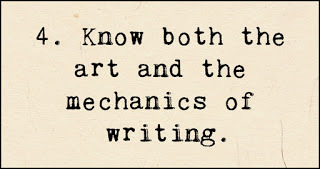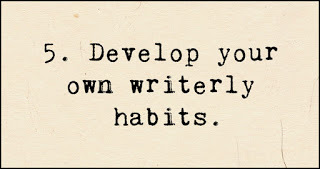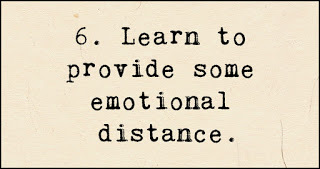Making the Move From Reader to Aspiring Author, part two
by Jan Drexler

Today's post, along with last month's part one (you can read that post here) are part of Seekerville's new "Let's Get Back to Basics" series. Because we know how overwhelming learning to become a published author can be, we want to give beginners a helping hand and help veterans refresh their knowledge.
If you remember, I am in the process of sharing six steps to make the transition from reader to aspiring author.
From last month's post:
Step 1: Live Your Life
Step 2: Read as if Your Career Depends on It
Step 3: Study the Concept of Story
And now - here are the next three steps:
Step 4: Understand the art of writing vs. the mechanics of writing

There are two parts of writing – there is the art , and then there are the mechanics .
Learning the art of writing is easy…and the hardest thing we will ever do. The secret to learning how to write is to write! What’s so hard about that? Well, if you’re a writer, you know the self-doubt, that discouraging voice in your ear, and the experience of writing pages and pages of what seems to be nothing.
But every word we put on paper (or in our computer file) is valuable. With every sentence, every paragraph, we’re learning how to write. The act of writing is what develops the writer.

Here’s your fourth assignment , part A:
Write 100 words. Write like no one will ever read it. Let the words flow. Avoid the urge to self-edit.
Then put that page away until tomorrow. Tomorrow you can read what you’ve written, but until then put it out of your mind. Take heart! You’ve written 100 words!
When you open your document or your notebook tomorrow, tweak those words. Do they say what you meant to say? Change some of the words you used for stronger ones. Switch one sentence for another one. (This is called revising – a particularly useful skill.)
Now that you’re happy with what you wrote yesterday, write another hundred words – or more. Make this practice a daily habit.
But there is another part to writing: mechanics .
If you’re a grammar geek like me, this part is easy. And hard. I cringe when people use the past perfect progressive tense when they mean to use the past perfect. (It’s a blessing. And a curse.)
Don’t worry. I do understand that not everyone is a grammar geek. There are some of you whose eyes glazed over when you read the preceding paragraph!
There is help out there. A simple (and free) one is the Grammarly app for your computer. You can find it here. There are also many books written to help you learn the basics of grammar and punctuation – between homeschooling and adult education, you have plenty to choose from. Go to Amazon and do a search for grammar curriculum. There are many inexpensive workbooks to help. One of my favorites is the one we used for my children when they were in high school: Easy Grammar Plus.
I want to say something especially important here, and then I’ll be quiet about this grammar and punctuation stuff (for now.) Here it is:
Writing is an art, and every artist needs to be able to use his or her medium. Painters need to understand watercolors, acrylics, and oil. Sculptors need to understand clay. Quilters need to understand fabric. And writers need to understand words. Don’t depend on an app like Grammarly to write for you – use your words like a paintbrush to convey your story to your readers.
So, here’s your fourth assignment , part B:
Do an internet search for “English verb tense charts.” Find and download a simple chart of English verb tenses. Refer to it as you write. Learn to recognize the different verb tenses and how to use them properly. I found this one on Pinterest: Easy Verb Tense Chart
Step 5: Learn and Practice the Habits of a Writer

What are a writer’s habits?
If you’ve been around Seekerville long enough, you have probably discovered that every writer works in their own way. Each writer develops their own habits and method of working.
My husband loves to tell me about James Patterson’s writing habits. According to a recent interview, Mr. Patterson writes seven days a week, fifty-two weeks a year. He gets up around five thirty, does some housework, writes a bit. Takes a walk for an hour or so, then comes back and writes until eleven or twelve. (I think my husband wants me to take afternoons off and sell books like James Patterson!)
But that schedule wouldn’t work for me.
Neither would anyone else’s.
But MY schedule works for me, and YOUR schedule will work for you.
The point behind developing habits is to have the habits – have the routine. Even if you can only eke one hour of writing time out of your weekly schedule, grab it! Own it! Make it your habit!
Other writerly habits can include things like journaling, using writing prompts to get the creative energy flowing, and developing a pre-writing routine. Whatever works for you!
Your fifth assignment : Find your writing time and make it a habit to always use that time for writing. Even if it’s only fifteen minutes a day…you can write one hundred words in fifteen minutes.
Step 6: Develop a thick skin - - your story is not YOU

This one came as a surprise to me as I was working on this post. I thought I had this covered…until I received a rejection letter last week. Ouch!
Oh, I know. Our stories are our babies! We’ve poured our heart and soul into that story! It is an extension of ME!
But no, it isn’t.
Once we hit the “send” button on our story, it is no longer part of us. It belongs to the world.
And sometimes the world doesn’t think our story will be a good fit at this time. Sometimes the world is looking for Amish stories instead of covered wagon stories. Or maybe our story wasn’t as ready for the big world as we thought it was.
This is where we need our thick skin. Which is another way of saying that we need to put some emotional distance between ourselves and our work.
When we receive a rejection, or a stinging criticism, or a bad review, this is what we do: Take twenty-four hours to get over it. Eat chocolate. Feel sorry for ourselves.
And this is what we don’t do: Never complain on social media about the situation. Never attack the reviewer/editor/agent/crit partner. Never think that we are any less talented of a writer than we were two days ago.
And then, after you’ve given yourself twenty-four hours (or maybe forty-eight, if it was a particularly bad experience,) pick yourself up. Dust yourself off. And go back to work.

We go back to work because we are writers.
Sure, we took a blow, but it didn’t really change anything, did it?
And it helped us to develop that thick skin we need.
For your sixth assignment ? There isn’t one. There is nothing I can suggest that will help you develop the thick skin you need except to write. Submit. Enter contests. Take the blows when they come (believe me, they will) and learn from them.
That's it! Six steps! I hope you use these six steps in the spirit that I shared them - a way to learn and grow as a writer. We're all in this together!
It's your turn now: Which of these steps has been the most meaningful to you?
One commenter will win a copy of a book out of my secret stash... If you're the winner, I'll give you your choice of several titles to choose from - and the list will include authors other than me! (Don't you love surprises?)

Today's post, along with last month's part one (you can read that post here) are part of Seekerville's new "Let's Get Back to Basics" series. Because we know how overwhelming learning to become a published author can be, we want to give beginners a helping hand and help veterans refresh their knowledge.
If you remember, I am in the process of sharing six steps to make the transition from reader to aspiring author.
From last month's post:
Step 1: Live Your Life
Step 2: Read as if Your Career Depends on It
Step 3: Study the Concept of Story
And now - here are the next three steps:
Step 4: Understand the art of writing vs. the mechanics of writing

There are two parts of writing – there is the art , and then there are the mechanics .
Learning the art of writing is easy…and the hardest thing we will ever do. The secret to learning how to write is to write! What’s so hard about that? Well, if you’re a writer, you know the self-doubt, that discouraging voice in your ear, and the experience of writing pages and pages of what seems to be nothing.
But every word we put on paper (or in our computer file) is valuable. With every sentence, every paragraph, we’re learning how to write. The act of writing is what develops the writer.

Here’s your fourth assignment , part A:
Write 100 words. Write like no one will ever read it. Let the words flow. Avoid the urge to self-edit.
Then put that page away until tomorrow. Tomorrow you can read what you’ve written, but until then put it out of your mind. Take heart! You’ve written 100 words!
When you open your document or your notebook tomorrow, tweak those words. Do they say what you meant to say? Change some of the words you used for stronger ones. Switch one sentence for another one. (This is called revising – a particularly useful skill.)
Now that you’re happy with what you wrote yesterday, write another hundred words – or more. Make this practice a daily habit.
But there is another part to writing: mechanics .
If you’re a grammar geek like me, this part is easy. And hard. I cringe when people use the past perfect progressive tense when they mean to use the past perfect. (It’s a blessing. And a curse.)
Don’t worry. I do understand that not everyone is a grammar geek. There are some of you whose eyes glazed over when you read the preceding paragraph!
There is help out there. A simple (and free) one is the Grammarly app for your computer. You can find it here. There are also many books written to help you learn the basics of grammar and punctuation – between homeschooling and adult education, you have plenty to choose from. Go to Amazon and do a search for grammar curriculum. There are many inexpensive workbooks to help. One of my favorites is the one we used for my children when they were in high school: Easy Grammar Plus.
I want to say something especially important here, and then I’ll be quiet about this grammar and punctuation stuff (for now.) Here it is:
Writing is an art, and every artist needs to be able to use his or her medium. Painters need to understand watercolors, acrylics, and oil. Sculptors need to understand clay. Quilters need to understand fabric. And writers need to understand words. Don’t depend on an app like Grammarly to write for you – use your words like a paintbrush to convey your story to your readers.
So, here’s your fourth assignment , part B:
Do an internet search for “English verb tense charts.” Find and download a simple chart of English verb tenses. Refer to it as you write. Learn to recognize the different verb tenses and how to use them properly. I found this one on Pinterest: Easy Verb Tense Chart
Step 5: Learn and Practice the Habits of a Writer

What are a writer’s habits?
If you’ve been around Seekerville long enough, you have probably discovered that every writer works in their own way. Each writer develops their own habits and method of working.
My husband loves to tell me about James Patterson’s writing habits. According to a recent interview, Mr. Patterson writes seven days a week, fifty-two weeks a year. He gets up around five thirty, does some housework, writes a bit. Takes a walk for an hour or so, then comes back and writes until eleven or twelve. (I think my husband wants me to take afternoons off and sell books like James Patterson!)
But that schedule wouldn’t work for me.
Neither would anyone else’s.
But MY schedule works for me, and YOUR schedule will work for you.
The point behind developing habits is to have the habits – have the routine. Even if you can only eke one hour of writing time out of your weekly schedule, grab it! Own it! Make it your habit!
Other writerly habits can include things like journaling, using writing prompts to get the creative energy flowing, and developing a pre-writing routine. Whatever works for you!
Your fifth assignment : Find your writing time and make it a habit to always use that time for writing. Even if it’s only fifteen minutes a day…you can write one hundred words in fifteen minutes.
Step 6: Develop a thick skin - - your story is not YOU

This one came as a surprise to me as I was working on this post. I thought I had this covered…until I received a rejection letter last week. Ouch!
Oh, I know. Our stories are our babies! We’ve poured our heart and soul into that story! It is an extension of ME!
But no, it isn’t.
Once we hit the “send” button on our story, it is no longer part of us. It belongs to the world.
And sometimes the world doesn’t think our story will be a good fit at this time. Sometimes the world is looking for Amish stories instead of covered wagon stories. Or maybe our story wasn’t as ready for the big world as we thought it was.
This is where we need our thick skin. Which is another way of saying that we need to put some emotional distance between ourselves and our work.
When we receive a rejection, or a stinging criticism, or a bad review, this is what we do: Take twenty-four hours to get over it. Eat chocolate. Feel sorry for ourselves.
And this is what we don’t do: Never complain on social media about the situation. Never attack the reviewer/editor/agent/crit partner. Never think that we are any less talented of a writer than we were two days ago.
And then, after you’ve given yourself twenty-four hours (or maybe forty-eight, if it was a particularly bad experience,) pick yourself up. Dust yourself off. And go back to work.

We go back to work because we are writers.
Sure, we took a blow, but it didn’t really change anything, did it?
And it helped us to develop that thick skin we need.
For your sixth assignment ? There isn’t one. There is nothing I can suggest that will help you develop the thick skin you need except to write. Submit. Enter contests. Take the blows when they come (believe me, they will) and learn from them.
That's it! Six steps! I hope you use these six steps in the spirit that I shared them - a way to learn and grow as a writer. We're all in this together!
It's your turn now: Which of these steps has been the most meaningful to you?
One commenter will win a copy of a book out of my secret stash... If you're the winner, I'll give you your choice of several titles to choose from - and the list will include authors other than me! (Don't you love surprises?)
Published on April 19, 2020 21:00
No comments have been added yet.



